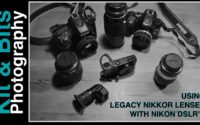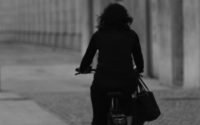Bokeh, Flash and Killing the Context – Streetcast #6 – 20th April 2019
Bokeh, softened backgrounds and flash can be great with portraits, flowers and other subject oriented imagery. For journalism however, the background is often an essential part of the image, by providing the context for the story.
Just like photojournalism, street photography also needs a context for a story. And more often than not any aesthetic of the image is a characteristic of the background rather than the subject alone.
Fast Glass
Fast lenses, often with a hefty price tag offering a nice soft out of focus are therefore not often suitable for street photography.
Older, cheaper and less fast glass is going to have the functional characteristics and ability to render most street photography images just as well as expensive fast glass. Indeed not only the price but often the weight of a faster lens is actually a downside.
By setting the aperture at f 5.6, or higher if the light allows, we are increasing the whole story approach to an image. Something that makes sense for street.
One can afford to have old manual lenses as they do not cost much today. And this despite the fact that the older lenses are often calibrated engineering masterpieces or lenses with character. By character of course we mean, distortion, aberration and other normally undesirable properties of the glass.
Enough about old glass, because the principle holds true for new glass too. Many of the kit lenses are similarly not that fast. Whilst I have not had a good experience with my Nikon kit lens, those from Fujifilm are both affordable and of great quality. I was lucky to have a play with my fathers setup and the quality is good. Kit lenses from the micro 4/3 companies are also good. Certainly at the typical apertures that would normally be used for traditional street.
So whilst many of the manufacturers today are driving the idea that fast is best; for us this is questionable. Don’t misunderstand I accept that bokeh is aesthetically pleasing for some photography genres.
Low Key Photojournalism
Street photography is a low key version of photojournalism, hopefully with an aesthetic element to enhance the story telling. But unlike portraits, our aesthetic is normally the shadows, textures and shape of the image as a whole. Isolating the subject from the background is not normally what street is about. But there are exceptions.
I also find images using flash to isolate the subject equally difficult to reconcile with the genre street. This too is likely to throw the background and isolate the subject.
Portraits of people that happen to be on the street is in my view not street photography. If the actual background of the “street” is so unimportant, why do we call it street photography? Images could just as easily be done in a studio with a blur in the background.
I have a view that is very much driven by the tradition of street photography as a form of candid journalism. And journalism needs context.
We need a Context
The genre has a history of backgrounds giving context and thus making a story. Henri Cartier-Bresson, to the best of my knowledge, never had extreme Bokeh in his shots, it was inappropriate with his work, just as it was inappropriate for his street photography. Imagine a silhouette of a man jumping, without the water, planks or industrial area. Imagine a cyclist moving so fast the shutter speed makes a blur without the staircase or the road. And so on.
Opening the lens for light can be necessary, but including the context is essential. So we are forced to compromise by balancing these two parts. In a way our genre is cheaper than most as the faster more expensive glass is not what we need.
But like landscape photography, the landscape of the street is an important part of most of our genre.
Cameras are tools and like most good tools they are valuable for a range of tasks. Depending on your version of street current fads and fashions may not be suitable. For traditional street, we certainly need to be careful not to be drawn into upgrading and exchanging kit when the features are not actually going to help us.



